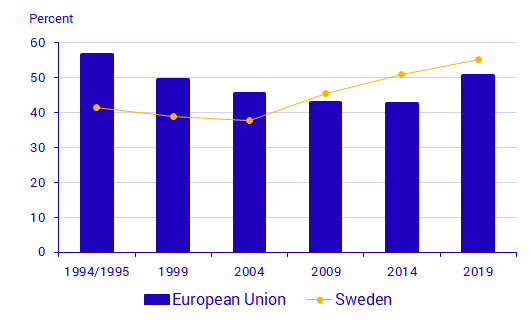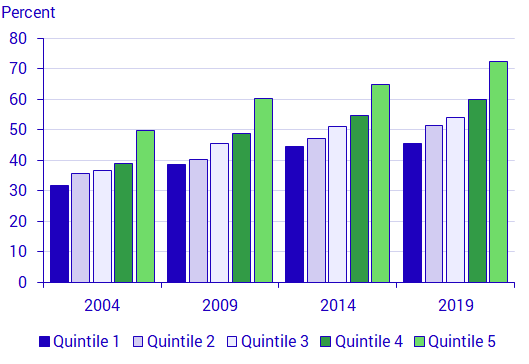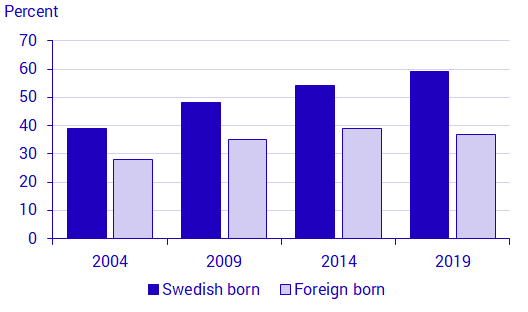European Parliament elections, voter participation survey 2019
Analysis of voter turnout in the 2019 European Parliament election
Statistical news from Statistics Sweden 2020-06-26 9.30
The European Parliament election in Sweden was held on Sunday 26 May 2019. Voter turnout was 55 percent, higher than the average in the EU and four percentage points more than in the 2014 European Parliament elections.

A comparison between various groups in the population shows differences in voter turnout. In Sweden’s European Parliament elections in 2019, voter turnout among women who were eligible voters was 56 percent, and the corresponding figure among men was 55 percent. Compared with the total number of eligible voters, the difference is one percentage point.
Voter turnout among men and women varies by age. Up to 70 years, voter turnout is higher among women than among men. Among persons 70 years and older, voter participation is higher among men instead.

Other results show that voter participation is lower among single persons, persons with a compulsory/upper secondary education, and persons with a low income level, while voter participation was higher among married and cohabiting persons, persons with a post-secondary education, and persons with a high income level.

Voter turnout among first-time voters in European Parliament election decreased
Statistics Sweden’s voter participation survey on the 2014 European Parliament elections showed that higher voter turnout led to more equal voting across age groups. In the 2019 election, levelling across age groups continued among persons between 30 and 74 years. At the same time, voter turnout dropped in the youngest age group, which earlier also noted the lowest voter turnout among the age groups. The largest increase in voter turnout compared with the 2014 European Parliament elections was noted in the age group 75 years and older.
The results show major differences in the group first-time voters. Voter participation is higher among first-time voters who attend or have attended study preparation upper secondary school programmes than vocational programmes. Regardless of upper secondary school programme, voter participation is higher among first-time voters who are attending an educational programme than among those who completed their upper secondary education. A more detailed analysis shows that first-time voters’ first-time voters’ inclination to vote is most strongly linked to whether at least one of their parents voted.
Voter turnout increased among people born in Sweden and decreased among people born abroad
Voter participation in the 2019 European Parliament elections was higher among Swedish born Swedish citizens than among foreign born Swedish citizens, 59 percent compared with 37 percent. Among foreign born persons, voter turnout was highest among persons born in the Nordics (excluding Sweden), the EU (excluding the Nordics) and South America. The proportion of Swedish born persons who voted has increased since the 2014 European Parliament elections, while the proportion has declined among foreign born persons.

Voter turnout among persons with disabilities was low
Voter participation was lower among persons with disabilities than among others, both in the 2018 Riksdag election and in the 2019 European Parliament election. The difference in voter participation between persons with disabilities and the rest of the population amounted to 6 percentage points in both elections. There are also differences based on the type of disability. A lower voter turnout is noted among persons with any impairment defined as a disability that is measured in the ULF/SILC, except hearing impairment. The lowest level of voter participation was among persons with a high degree of reduced mobility. A distinctly lower voter participation was also noted among persons with a high degree of impaired functioning and persons with a neuropsychiatric disorder than among the rest of the population.
Major regional differences in voter turnout
A regional analysis shows clear differences in voter turnout between different electoral districts. In the 2019 European Parliament elections, voter participation was less than 30 percent in 183 electoral districts. At the same time, there were electoral districts in which voter turnout of more than 80 percent was noted. It is clear that individuals’ characteristics that are linked to voter participation, such as country of birth, education and income among the population of eligible voters, are also evident when these characteristics are aggregated to electoral district. Above all, voter turnout was low in districts with a large proportion of foreign born persons among the eligible voters.
Definitions and explanations
In the voter participation survey, the population consists of persons entitled to vote in the Swedish election to the 2019 European Parliament. The persons entitled to vote can be divided into three mutually exclusive categories:
1. Swedish citizens who turn 18 years old by Election Day and are registered as living in Sweden.
2. Swedish citizens living abroad who are included in the electoral roll. Swedish citizens living abroad who turn 18 years old by Election Day and who at some point have been registered as living in Sweden are entitled to be included in the electoral roll. Persons who have been registered as living in Sweden at some time in the last ten years are automatically included in the electoral roll. Swedish citizens living abroad who are not included in the electoral roll must apply to be included in the electoral roll. A vote submitted from abroad is also regarded as an application to be included in the electoral roll. An application to be included in the electoral roll by a Swedish citizens living abroad is automatically valid for ten years.
3. Citizens in any EU Member State who turned 18 years old by Election Day, who have been registered as living in Sweden for 30 days ahead of Election Day and have registered to vote in the Swedish election instead of the European Parliament Election in the country of citizenship.
Within the scope of this task, the Survey on Living Conditions (ULF/SILC) was used in order to examine voter participation among persons with disabilities.
The 2019 voter participation survey was carried out as a total population survey for the first time in a European Parliament Election, which means that statistics are available by county and by municipality. Statistics Sweden’s Statistical Database includes statistics on voter turnout presented by sex, age, country of birth, education and income for the whole country, by county and by municipality.
Publication
Feel free to use the facts from this statistical news but remember to state Source: Statistics Sweden.
